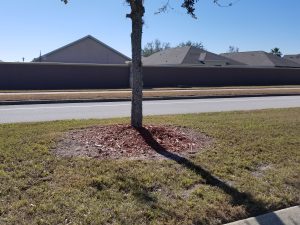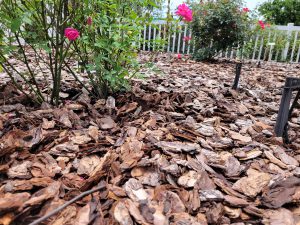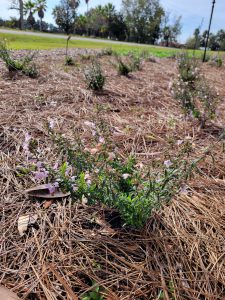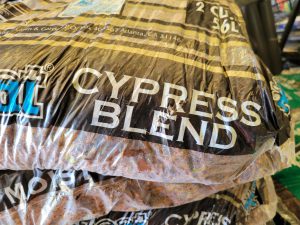Mulch can add the finishing touch to your landscape. With so many options out there, how can you pick what works best for you? Are some mulch options better than others?
There are two broad categories of mulch: organic and inorganic. Organic mulch is derived from something that was once alive, such as pine bark or melaleuca. Organic mulch has the added benefits of releasing nutrients into the soil as it breaks down and increases water holding capacity in the soil. Organic mulch does need regular replacement as it decomposes. Inorganic mulch was never alive. This would include things like rubber and gravel. Inorganic mulch does not need to be replaced frequently, but it does not provide added nutrients and water holding capacity.
Organic Mulch
When using mulch in your landscape two to three inches provide numerous benefits to the landscape. Some of these benefits include:
- suppressing weeds
- conserving water
- moderating soil temperatures.
- providing nutrients to the soil.
When mulching around woody plants, keep the mulch off of the trunk. Mulch piled on the trunk of trees and shrubs can lead to pests, diseases, and rot. Think of it like a donut vs a volcano. Donuts are good, volcanos are bad.

Not all organic mulch is created equal. Take a look at the various options below.

Pine Bark: a byproduct of forest industry practices, this product is readily available. It provides soil cooling in the summer by controlling moisture. It also provides insulation for plants in the winter. Pine bark mulch can give a landscape a finished look with a natural color. This breaks down slowly providing nutrients to plants. The slow break down leads to longer lasting much. Pine mulch, including pine straw can increase the pH of the soil. This option is great in pots as well as landscapes.

Pine Straw: The pine needles from paper producing pine plantations can be used as mulch. This is frequently used in areas looking for a more natural aesthetic. You can also collect this from your lawn if you have pine trees. Pine mulch will settle, and needs replaced yearly. This is often the cheapest mulch option.
Fallen Leaves: If you have ever racked leaves, then dreaded bagging them up, consider using them as mulch instead! They can be mixed with grass clippings to provide a high nutrient mulch for landscape beds. If you have larger leaves, mow them before using as mulch. Mowing speeds up the breakdown process, increasing nutrients available to plants. While this mulch provides nutrients and insulation, you will need to replace it frequently as it breaks down. If you have a lot of trees, this should not be an issue. One downside is that it looks less manicured than other options discussed here.
Melaleuca: Melaleuca trees are an introduced invasive species in Florida. This mulch is produced by chipping the invasive trees. Seeds are destroyed though a curing process, so no need to worry about them sprouting in your landscape! This mulch has a similar look to cypress mulch but is more environmentally beneficial to use. Additional benefits include slow decomposition, natural properties that deter pests and the retention of the color.
Eucalyptus Mulch: Sharing many similarities with Melaleuca, eucalyptus mulch is another option to consider. Grown on plantations, the resulting mulch retains the color, may repel insects in the first 3-6 months and represses weeds. Unlike melaleuca, eucalyptus is legal to grow in Florida.
Dyed Mulch: Dyed mulch is not of great quality. It is not because it is dyed, it is because the wood comes from a range of recycled wood. This can include pallets, wood scraps, demolition waste, and more. The recycled wood can be contaminated with various chemicals. The wood is also very dry. This results in a slower break down of the materials. Dyed mulch can take nitrogen away from plants during decomposition, rather than provide nitrogen.

Cypress Mulch: Cypress mulch should be avoided. It is difficult to determine the origin of this mulch. Some harvesting practices can be damaging to endangered ecosystems. It may attract termites
Utility Mulch: This product is a mix of plants that have been mulched during routine utility pruning. Often containing weed seeds and potential disease-causing agents, you will want to consider its use carefully. The benefit is that it is often free, and you can get a large amount at one time.
Inorganic Mulch
Gravel/Rocks: Gravel and rocks do not prevent weeds. You will have to place a water permeable weed barrier on the ground before installation. You will not get the benefit of added nutrients or water holding with this cover type. While they will last a long time, cleaning is required. Use this in areas with potted plants, or in more arid landscapes.
Rubber Mulch: Made from recycled tires, this can work better in play areas then in landscape beds. There are several concerns with rubber mulch including possible toxins leaching into the soil, very high soil temperatures because of the heat absorption of the rubber, and it does not do well suppressing weeds. While it will not need replaced often, there is no real benefit to plants.
Are you interested in seeing some mulch examples in person? Come visit our Discovery Garden at 1951 Woodlea Road in Tavares to see examples of rock, pine bark, and pine straw mulches in our various gardens.
Additional Resources:
https://gardeningsolutions.ifas.ufl.edu/care/planting/mulch.html
https://edis.ifas.ufl.edu/entity/topic/mulch
https://ffl.ifas.ufl.edu/about-ffl/9-principles/principle-4-mulch/
 0
0
